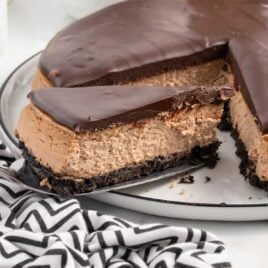Baileys Cheesecake
Featuring a delicious Irish cream flavor and decadent creamy texture, this Baileys cheesecake is an indulgent dessert that is worth the effort.
Servings: 8
Calories: 945kcal
Ingredients
Crust
- 24 chocolate creme cookies, original Oreos
- 3 tablespoons salted butter, melted & cooled
Cheesecake Batter
- 24 ounces cream cheese
- 1 cup granulated sugar
- 1 tablespoon unsweetened cocoa powder
- 2 large eggs
- 1 large egg yolk
- ¾ cup sour cream
- ¼ cup Baileys Irish cream liqueur
- 1 tablespoon heavy cream
- 1½ teaspoons vanilla extract
Ganache
- 8 ounces semi-sweet chocolate baking bar, finely chopped
- 3 ounces heavy cream
- 1 ounce Baileys Irish cream liqueur
- 3 tablespoons clear corn syrup, for an optional glossy ganache
Instructions
- Preheat the oven to 325°F. Line the bottom of a 9-inch springform pan with a parchment round. Lightly spray the sides of the pan with baker’s spray. Wrap the outside of the springform pan with 2 pieces of heavy-duty aluminum foil. Be sure to get the aluminum foil as high up on the sides as possible with little to no gaps. You do not want any water from the water bath to seep into your pan. Set aside.
- To make the crust, add the chocolate creme cookies to the bowl of a food processor. Pulse until you get very fine crumbs.
- Add the chocolate cookie crumbs to a medium bowl with the melted butter. Stir to combine.
- Press the cookie crumbs in an even layer into the bottom of the prepared springform pan. Bake for 10 minutes. Allow the crust to cool on the counter while you prepare the cheesecake batter.
- To make the cheesecake layer, add the softened cream cheese to the bowl of a stand mixer fitted with a paddle attachment. Beat on medium speed for 1-2 minutes or just until the cream cheese is smooth and has no lumps.
- To the bowl of the stand mixer, add the granulated sugar and unsweetened cocoa powder. Beat again just until the cocoa powder is fully incorporated.
- Turn the mixer to low and add the eggs and egg yolk, one at a time, until all the eggs have been fully incorporated. Do not overmix and beat too much air into the batter.
- Add the sour cream, Baileys Irish cream liqueur, heavy cream, and vanilla extract. Beat one last time just until all the ingredients are fully combined and the batter is smooth. You will need to scrape down the sides and bottom of the mixer bowl between ingredient additions to ensure that you thoroughly mix the batter without overbeating it. You do not want air bubbles in your cheesecake batter.
- Pour the Baileys cheesecake batter into the baked crust and smooth the top. Tap the cheesecake on the counter to help force any air bubbles in the batter to the top.
- Place the Baileys cheesecake into a large roasting pan and very carefully pour very hot water into the pan until it goes about ½-¾ inch up the sides of the springform pan. Do not overfill the pan with water. Depending on the size of your roasting pan, you may need 4-5 cups of hot water. Be very careful not to get any water into your cheesecake batter. Bake for 1 hour and 15 minutes or until the center just barely jiggles when moved.
- Once the cheesecake has baked, turn off the oven and crack open the door about 1 inch to allow the cheesecake to cool slowly, and start to set up for 1 hour. Remove the cheesecake and refrigerate for 8 hours to overnight to chill and set up completely.
- Once the Baileys cheesecake has fully chilled, you can make the ganache layer by adding, to a microwave-safe bowl, the finely chopped semi-sweet chocolate baking bar and heavy cream. Microwave on high for 1 minute (I used a 1000-watt microwave), then allow the chocolate and cream to sit for 1 minute on the counter to allow the chocolate to soften.
- Add the Irish cream liqueur and optional corn syrup to the warm chocolate. Whisk until smooth and silky.
- Carefully pour the ganache onto the top of the chilled cheesecake. Use an offset spatula to spread the ganache into an even layer, being careful not to drip the ganache down the sides of the cheesecake. Chill the ganache-topped cheesecake for 1 hour or until the ganache firms up enough to slice and serve.
- This Baileys cheesecake is best served chilled. You can store this cheesecake, in a covered container, in the refrigerator for up to 1 week. For longer storage, you can freeze this cheesecake tightly wrapped for up to 2 months. You will need to thaw the cheesecake completely in the refrigerator.
Notes
- You do not need to add the clear corn syrup to the ganache. The corn syrup keeps your ganache as silky as possible, even with refrigeration. If you do not add it, your ganache will still taste and set up fine; however, it will get a matte finish once chilled. You can always bring your cheesecake to room temperature if you want the ganache to soften up a bit and not be as matte-looking.
- Ensure the cream cheese is softened at room temperature to ensure a smooth and lump-free cheesecake filling.
- Oven temperatures vary and may need to be recalibrated periodically to ensure they are accurate. Make sure to keep a close eye on your cheesecake as the suggested baking time approaches.
Nutrition
Calories: 945kcal | Carbohydrates: 81g | Protein: 12g | Fat: 63g | Saturated Fat: 35g | Polyunsaturated Fat: 4g | Monounsaturated Fat: 19g | Trans Fat: 0.2g | Cholesterol: 194mg | Sodium: 481mg | Potassium: 470mg | Fiber: 4g | Sugar: 61g | Vitamin A: 1701IU | Vitamin C: 0.3mg | Calcium: 154mg | Iron: 8mg
